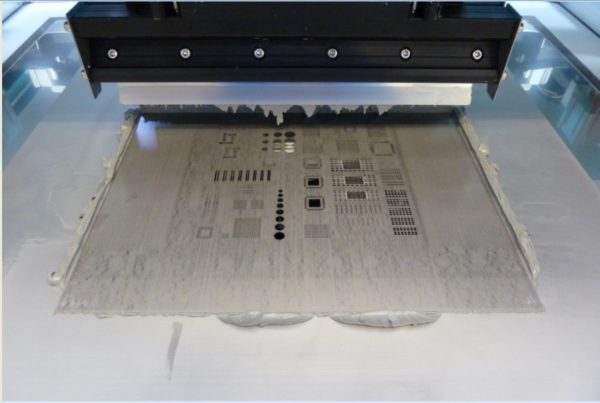Actualités
It goes without saying that myProto customers can rely blindly on the quality of our PCBA’s . This quality is partly determined by the stencils made by Rotec at Arendonk (Belgium). myProto talked to Tom Meeus, co-founder of Rotec, about stencil technology and the importance of good stencils during electronic production.
 During the electronic production process, a stencil ensures that the correct volume of solder paste ends up at the correct place on the PCB. To guarantee the constant quality of the PCBA, the adding of solder paste has to be exactly the same; this applies to five PCBs as well as ten thousand PCBs. Tom Meeus: “Miniaturizing the components makes it more difficult to add the correct amount of paste volume. When customers want to place a micro-BGA with a pitch of 0.4 mm or smaller for instance, the stencil is equally important as the solder paste. Our advice regarding our stencil and solder paste volumes are very accurate, because of our internal combination testing. This has a direct positive influence on our production yield of complex PCBAs.
During the electronic production process, a stencil ensures that the correct volume of solder paste ends up at the correct place on the PCB. To guarantee the constant quality of the PCBA, the adding of solder paste has to be exactly the same; this applies to five PCBs as well as ten thousand PCBs. Tom Meeus: “Miniaturizing the components makes it more difficult to add the correct amount of paste volume. When customers want to place a micro-BGA with a pitch of 0.4 mm or smaller for instance, the stencil is equally important as the solder paste. Our advice regarding our stencil and solder paste volumes are very accurate, because of our internal combination testing. This has a direct positive influence on our production yield of complex PCBAs.

Basically, two materials are being used for creating stencils: stainless steel and nickel. Tom Meeus: “Stainless steel is used the most. A laser cut nickel stencil is more expensive, but it has a better wear resistance. We only advise nickel with larger volumes but for the most part stainless steel will suffice. Recently, we started using an alternative for stainless steel: HR2 steel. HR2 steel is a more advanced kind of stainless steel which ensures a better release of solder paste. This is a good alternative with small and critical components.”

With Rotec myProto consciously chooses quality in material as well as advice. There are cheaper alternatives, but those come with risks. Tom Meeus: “Of course there is a difference in quality. We regularly see that people use kinds of stainless steel of a lesser quality. More often we see that the stencil design rules are not followed. The defects resulting for example are: closures, voiding, solder balls or opens. For a perfect result you have to master the art of combining the most optimal design rules with the correct paste and stencil.”
The alternative for a stencil and solder paste is solder paste jetting. The main advantage of this technology is that you don’t need a stencil. This is a less expensive method even though the jetting machine needs to be programmed. The biggest disadvantage of this technology is speed, or lack of it. Tom Meeus: “Jetting can be a good option to verify the circuit or a very small number of PCBAs. Because we see that paste printing gets more difficult with increasing miniaturization, we believe it is advisable to incorporate stencil design and therefore stencil verification in the PCBA prototype phase. If you do not do this, it can potentially become a problem when you want to start producing the series. Worst case scenario, you can encounter problems that need a redesign of the electronics.
myProto supplies prototypes of serial quality. To deliver on this promise, stencil technology is of the utmost importance. The stencils made by Rotec makes sure that myProto is ready to produce series immediately. myProto supplies PCBA prototypes from five working days. The stencils has never been the bottleneck. Rotec has their own cutting machine that gives them a delivery time of only two working days. They can deliver faster if it is really necessary.
Tom Meeus: “myProto is a very dynamic and young company with an eye for quality and a continuing aim for customer satisfaction. The cooperation between myProto and Rotec is very interactive; we try to come to solutions together. Because myProto does not wish to give in on the quality of stencils and paste, they are capable of producing high-quality prototypes and series very quickly.”
Membre de


